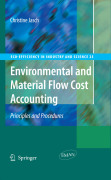
Environmental and material flow cost accounting: principles and procedures
Jasch, C.
Recognizing the increasing importance of environmental issues, energy prices,material availability and efficiency and the difficulty of adequately managing these issues in traditional accounting systems, several companies all over the world have started implementing Environmental and Material Flow Cost Accounting (EMA and MFCA). ‘Environmental and Material Flow Costs Accounting’ explains and updates the approach developed for the United Nations Department of Economic and Social Affairs (DSD/UNDESA) and the International Federation of Accountants (IFAC) and in addition includes experiences of several case studies and recent developments regarding EMA and MFCA in national statistics and ISO standardization Explains how to install an environment and material flow-relatedinformation system that is consistent with the accounting information system and thus auditable for environmental and sustainability reports and greenhousegas emission permits Up-to-date and relevant for manufacturing companies INDICE: From the contents Foreword.- Executive Summary.- 1. What is EMA and why is it relevant?- 2. The input side of the material flow balance.- 3. Theoutput side of the material flow balance.- 4. Environmental performance indicators.- 5. Environmentally relevant equipment.- 6. Monetary information.- 7. Linking physical and monetary information.- 8. Case study of a brewery.- 9. Howto organize an EMA pilot project.- 10. Annex.- References.- Index.
- ISBN: 978-1-4020-9027-1
- Editorial: Springer
- Encuadernacion: Cartoné
- Páginas: 200
- Fecha Publicación: 01/09/2008
- Nº Volúmenes: 1
- Idioma: Inglés
